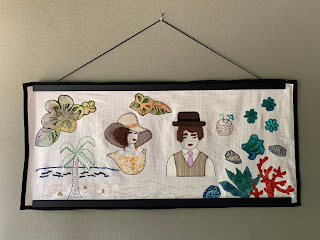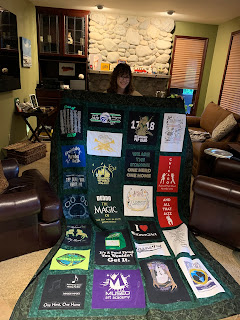Happy New Year!
The gifts are all distributed, the holiday trip is complete, and now it is time to reveal what I've been spending all my "spare" time doing for the last couple of months!
Upcycled Mint Tin Mini Albums:
The most time consuming of my gift projects this year was my group of upcycled mint tin mini-albums. The extra time was not due to construction, but just the nature of how I approach collage in general - I tend to spread out all potential components (paper, dimensionals, paint, etc...) shifting options and items around until I find the final combination that I am happy with.
We'll start with the photos of the finished projects
I put small dimensionals on the front cover of each album, the ribbon poking out of the lid is the tab to pull the album pages out.
I used one paper pattern for the interior pages, and chose alternating red and green patterned papers for the fold out pages.
Fully extended, the albums are meant to stand upright as two-sided display. I left the pages blank for the recipients to add photos/art work/etc... from their holiday celebrations.
To begin construction, I start by taking the lid off the mint tin, line the tin parts up on the chosen paper, trace around the tin, and cut out the outer cover. I also trace and cut the paper for the interior of the tin, checking the size and trimming the interior paper slightly smaller so that it will fit.
Always check for correct size before adhering!
Once the papers have been chosen, I sand the outside of the tins and paint the exterior edges.
While the paint dries, I cut the folded paper for the interior pages. I used plain white paper as the base for my accordion-folded pages, cutting a strip 12 inches long with a width that would fit inside the tin, and I scored the page every 2 inches to create the accordion fold. I then clipped the corners with one of my corner punches to make them rounded.
I cut the interior green and red pages slightly smaller than the accordion page, clipped the corners with my corner punch, and then glued them to the pages. I made a pull tab out of ribbon, which I glued to the end page prior to adding the decorative paper on top.
Here are a few finished tins showing the tin closed, open, and unfolded.
The interior hinges are two additional pieces of ribbon which I attached to the interior of the tin with double stick tape prior to gluing down the interior paper. I did not take photo of that part in progress, but hopefully you can see how it works from this zoomed-in shot.
One thing that I had changed from my original plan was the exterior of each tin. After having painted and constructed two albums, I discovered that the paint was chipping in several spots. I've painted tins before without a problem, so I presume that I did not sand these tins enough prior to construction. As a fix, I decided to cover the exterior edges with thin strips of paper instead of paint. This made a nice, smooth finish, however the tins no longer closed all the way - which I think is fine, as they aren't really meant to stay completely closed anyway.
Block Carving Project
In April of 2017 I enjoyed a crafty afternoon in Portland carving linoleum blocks with my friend. During my visit she introduced me to carving blocks which were much easier on my arthritis than the hard linoleum blocks I'd had in my craft stash. Having experienced this magical material, we took a ride down to her local art store where I picked up a few pieces, along with some printing paint, for me to take back home with me. These supplies sat in my "Someday I'll do this" area of my craft room until this past fall, when I determined that I could not allow myself to load up on another new set of art materials until I at least tried to work with the brand new set of art materials I already had. To that end, I decided to try to carve a design that could be used as this year's Christmas card.
My initial attempt was a simple design of snowflakes and swirly wind, printed in blue. It took a few tries to get the correct amount of ink and pressure for a nice print.
I was inspired by my first attempt, but limited in my choice of color because I'd only purchased small tubes of shades of blue paint to begin with. I bought more blocks and paint colors online, and thought I might attempt to do a multi-layer effect, carving tree branches on one block in green, and ornaments on another in gold, then layering the two.
The layers did not turn out the way I had hoped, the green branches showed through the gold paint, so I went back to the printing portion and did a three step process instead... printing green branches, then black ornaments, then gold on top of the black. The end result was a sort of shadow effect - an example is on the right below.
This is a shot of the work I shared at my November APex meeting.
Although I liked the final result of the ornament photo well enough, my mind was buzzing with more ideas. I thought it would be fun to do some carvings based on photos that I've taken. The first photo that came to mind for this was a head shot of a nene I'd taken on my first trip to Kauai. Rather than draw freehand, I thought it would be more accurate to trace the photo and transfer it onto the stamp.
The process actually worked precisely the way I had hoped it would... I traced the parts of the nene that I wanted to have on the block, turned the tracing paper over onto the block, rubbed the tracing paper (which transferred the pencil lead onto the block) then carved around the pencil to bring out the nene.
I used the same process on a photo of a black-capped chickadee which I'd taken last year, and after much deliberation I ended up using this print for my Christmas cards.
All of my other Christmas gift projects were fairly straight forward:
Cork message board:
I actually had enough corks to make two of these as gifts this year. I bought the frame, poured out my corks, and went to work designing a pattern to put them in. Some of the corks needed to be cut down to size, so I steamed those for 10 minutes to soften them up and cut them with a serrated knife. After deciding on a final pattern, I then glued the corks down with a super strong (and stinky) glue to hold them in place, attached the wall hanger on the back, and there you have it - a cork message board.
Photo Coaster Set:
I made a set of photo coasters for D's mom using photos from our trip to Jamaica back in 2009. I had the photos printed, cut them down to size, glued them to the coaster squares, sealed the top with resin, let that cure for a few days, then covered the bottoms of the coasters with soft felt.
Reusable Coffee Cup Cozies:
I had a lot of fun making these coffee cup cozies! I found the pattern online and chose fabrics based on the recipients. The batting I used for the inside is an insulated batting made for things like pot-holders, so they should keep the coffee hot and the hands protected. This project also involved digging into my stash of buttons.
I just love this Hobbit-themed fabric! Here is how the cozy looks on a cup.
I used paper from my Christmas paper stash to cut the flat cup-shape out for each cozy to wrap around.
Pencil Pouches
These pencil pouches had a dual-use in wrapping. As a Christmas surprise I had picked up tickets to the local showing of Broadway's Lion King, and I wanted a clever way to wrap the tickets. G uses a separate notebook for her scripts for drama club, so I found this Playbill themed fabric and I made a couple of pencil pouches for her. The one on the right has an elastic band built into it which holds it to the outside of her script notebook. The larger one on the left is a loose pencil pouch for her to keep other stuff handy. I tucked a copy of the show tickets in the pencil pouch when I wrapped it for her.
Recipe Towel
I saw this idea online and thought it was very clever, so I made one for my sister. I scanned one of our mom's recipes, flipped the image, printed it on T-Shirt transfer paper, then transferred it onto a tea towel.
Custom Ears
As a post-Holiday gift to myself, I made a pair of Chewbacca- themed Mickey ears just prior to our New Year's trip to Disneyland. I did wear them for the entire duration of the trip, and random people would do a Chewey-call at me as I passed. I was also singled out by Kylo Ren as a rebel spy on Star Tours (perhaps one of my proudest moments on a ride ever) I made the ears from craft fur and put them over ear-shapes cut from foam to give them structure. The belt is made from felt, which I glued together and put across the ear prior to sewing the pieces together. I made the bow from black felt and glued it in the middle. I had originally wanted to make the bow from Porg-printed fabric, however I could not find any Porg fabric anywhere (not even Spoonflower!) and I didn't have time to design my own... so as a compromise I made the bow from black felt and purchased a Porg pin to put on it.

This shot shows the ears after adding the porg pin. The fuzz could not be tamed, even with hair spray, so after day 1 I gave up on combing the ears.
This photo was pre-planned for months - hence the immense grin on my face. Look at how the belt on my ears lines up PERFECTLY with Chewey's belt!
I now find myself in that post-holiday meandering, debating about whether or not I should pack Christmas crafts away immediately or give myself that bit of time with my vintage findings that I'd hoped to have prior to Christmas. On the one hand, it seems a shame to pack it all up when I have ideas now, on the other hand I have no shortage of other projects that I want to accomplish before next year's Christmas gift blitz sideswipes me.
For the time being, I think I'll just enjoy another cup of tea while I straighten up my work space and contemplate my options.
Happy New Year, and may the force be with you!


































































